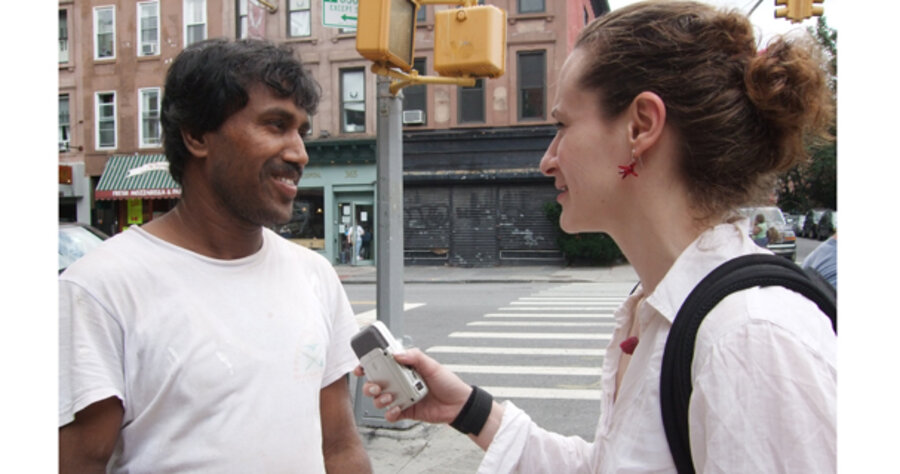Online tales of everyday heroes
Loading...
Natalia Paruz, who performs in New York subway stations, couldn’t help but notice a blind couple getting off a train at the Lexington and 59th Street stop. The pair was clearly unfamiliar with the station and asked a young man rushing by where the exit was located. Rather than merely point them in the right direction, he offered to escort the couple to the door.
“He was obviously in a hurry,” recalls Ms. Paruz. “But he decided to put his life on hold for a moment and help these people.”
Playing music around the city, Paruz has witnessed countless “smaller acts of heroism.” She has long wanted to share with others the kind deeds of New Yorkers, who she says have been unfairly stereotyped as scary and unhelpful.
Now, she sends these anecdotes to Hero Reports. Launched last month as a student project, the website asks for feel-good stories from across New York and other cities.
Hero Reports aggregates, arranges, and archives brief narratives about everyday good deeds in different mediums – words, pictures, audio, and video.
Massachusetts Institute of Technology grad student Alyssa Wright designed the website in response to the New York subway safety slogan: “If you see something, say something.”
This counterterrorism campaign, rolled out after the attacks of Sept. 11, 2001, “brought suspicion into our everyday spaces,” says Ms. Wright. “Our awareness of body and space has shifted since 9/11.”
Feeling manipulated by the subway ads, Wright started Hero Reports to balance what she saw as a message of fear with her own online message of hope.
New York-based writer and blogger Nubia Duvall, whose observations of city-dwellers at their best have been featured on the website, believes that Wright’s project is timely.
“Since 9/11, there’s been a negative emphasis on observing what’s going on around you,” she says. “You’re on the lookout because something bad might happen. But conversely, good things happen, too.”
Hero Reports started as a tool of action as well as observation. Wright labels her project as a “technology of empathy,” because it acknowledges the little deeds of others – giving up a seat for a pregnant woman, helping an old man with his groceries – while encouraging people to perform their own small acts of kindness.
Tikva Morowathi, a designer who has contributed several audio reports to the website, says Hero Reports provides the rare opportunity to acknowledge others.
“Recognizing other people … is not really part of our day-to-day activities,” she says. “Hero Reports makes me question what I can acknowledge somebody for, and that’s a great way to think about the people around us.”
Wright also sees her project as an attempt to reclaim the notion of heroism.
“The word ‘hero’ is used for firefighters, policemen, Iraqi soldiers,” she says. “But if heroes are necessarily people who are trained and professional, it becomes easier to pass the responsibility on to them. Your personal accountability is reduced.”
“The Take Away,” a morning news program from WNYC and Public Radio International, has broadcasted several of the site’s audio segments. John Hockenberry, the show’s host, says that the most powerful feature of Hero Reports is the website’s ability to digitally map where the good deeds took place. People who share their stories can type in where the event occurred and the site will highlight that area on a special Google map of the city. This allows for a spatial relationship between ordinary heroes and their New York City neighborhoods, he says.
“It’s intuitively clear to our listeners that they should report heroic activities because that’s one way in which to value their communities,” says Mr. Hockenberry. “But the information they submit is given added value in the way that it is graphically represented. It’s not just about a website anymore, it’s about seeing whether there have been heroic incidents on my block. The technology lets us reshape the way we think about our local society.”
In addition to user-submitted pieces, Hero Reports aggregates good-news articles published by mainstream media outlets and scours the blogosphere for additional stories with a positive urban outlook.
“There’s so much bad news in the world – on the news, on radio, TV,” says Paruz. “Good stuff happens, but that doesn’t get promoted.”
Wright adds that the ability to aggregate news content according to a theme gives it more meaning.
“I don’t believe that technology will save the world,” she says. “But technology does have the power to bring things together. Information about good deeds is out there in the newspapers and blogs. But you only notice it when you put it all together.”
By doing so, Wright is helping people reach across their online and offline social networks and engage in a dialogue across time, space, and media. And, by using technology to enable, archive, and reclaim heroism, Wright has done something heroic enough to report on.
Hero Reports is located at: www.heroreports.org





